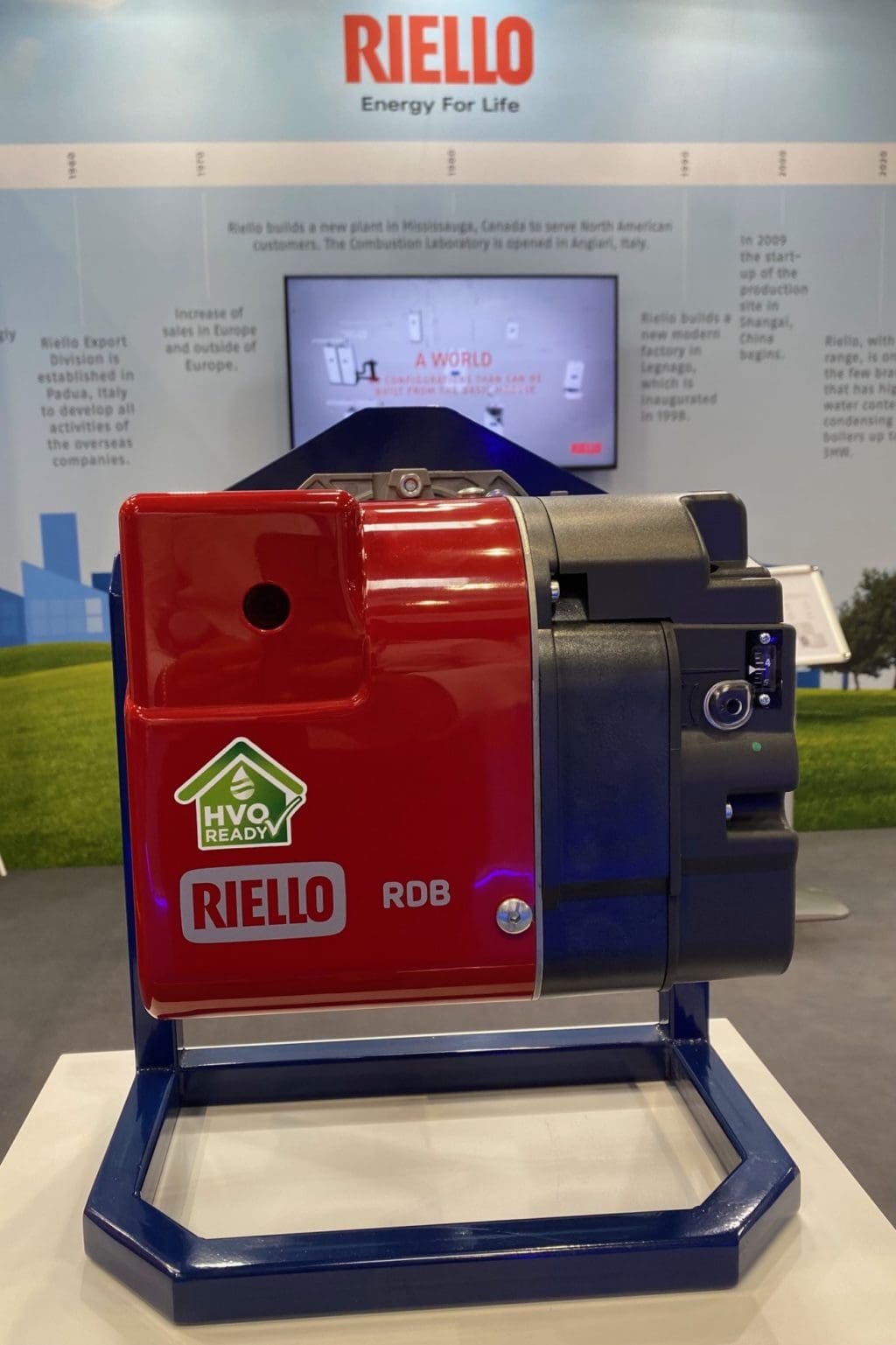
Renewable heating liquids
As has been documented several times in recent publications of Oil Installer, the Oil industry, in conjunction with OFTEC and UKIFDA, has been undertaking a great deal of work in promoting renewable heating liquids and lobbying Government to evidence that the industry is ready to help the UK achieve Net Zero by 2050 by switching from current fossil fuel oils to renewable liquids, such as HVO.
The message needs to get out
During the recent InstallerSHOW held at the NEC in Birmingham, Riello showcased one of their RDB2.2 BX burners that is fully compliant with HVO operation. This created high levels of interest and received very positive feedback from guests to the stand, with some engineers and industry colleagues having very little or no knowledge of HVO and why we need to adopt a switch.
This lack of awareness makes clear that whilst we, in the industry, continue to push for a switch to HVO, the message is not getting out to the wider market. It will be key to protecting the future of our industry that, we all align now to push the message to a much broader audience.
An obvious and simple solution
As has been previously reported, HVO provides a perfect solution for the off-grid sector as it is a near ‘drop-in’ replacement for kerosene in residential heating systems, and a full ‘drop-in’ for gasoil as generally used in commercial & industrial heating equipment.
To switch from kerosene to HVO requires only low-level intervention and upgrading of the current boiler and oil supply system, with no requirement to adapt the heating system to suit low temperature technologies. As such, the cost to the householder will be minimal and is likely to form part of a service visit.
Present modelling forecasts the costs of upgrading an oil boiler to suit HVO at around £500 – far lower than the cost of converting a conventional heating system to low temperature technology. We would always fully endorse any upgrading or improvement of heating systems and/or buildings to improve overall efficiencies, but this is not a pre-requisite – as it is for some low temperature systems – when switching from kerosene to a fully renewable HVO liquid fuel.
With regards HVO itself, it is non-toxic, non-carcinogenic, biodegradable, has no smell and is much safer to store when compared to current fossil fuels. The condensate produced from the combustion of HVO is almost pH neutral, making it over 90% less acidic than kerosene and gasoil condensate. A switch to 100% HVO provides an estimated 88% reduction in carbon, compared to current fossil fuels.
HVO ‘ready’ but the cost is too high
As an industry, manufacturers are now in a position where the majority are ready and waiting to offer HVO complaint products into the market. At Riello we have been working closely with all of our OEM customers in developing the correct specifications and completing thorough test programmes, along with lifecycle testing, to be able to provide fully HVO ready burners. I think it is clear that the industry is ready to switch to renewable liquid fuels, but we need government to support and back this.

At present, HVO is classified as road fuel with tax and duty accordingly applied, making it more expensive than kerosene. The Government therefore needs to mitigate this by classifying HVO as a residential heating fuel, reduce taxation and duty and/or provide grants to fuel suppliers to reduce the upstream cost. This will allow off-grid householders to switch to an environmentally friendly, renewable heating solution at a more affordable cost.
As we all drive towards a cleaner future and look to make significant carbon reductions to improve the environment for future generations, switching off-grid properties from fossil oils such as kerosene to HVO has the benefit of providing immediate carbon reductions which will be necessary if we are to hit the Government targets, whilst also minimising costs to householders. Therefore, HVO has the potential to make the switch to renewables much easier and more affordable for the off-grid sector when compared to forcing through a switch to different technologies that involve much higher installation costs.
Ultimately, government policy has to be technology-neutral and consider a combination of options to avoid penalising householders in ‘hard-to-heat’ homes. Thus, it’s clear that adopting a switch to HVO will greatly assist the Government in achieving it’s 2050 Net Zero targets.
HVO availability
The UK Government has previously raised concerns on the availability of HVO to support the UK markets as it looks to prioritise any such renewable liquids to sectors that do not have any alternatives, such as aviation. However, global forecasts evidence large increases in the production of HVO over the next 5 years, with European refineries looking at a potential three-fold increase and the USA looking at a six-fold increase. It is estimated that current global production of HVO of approx. 7MT per annum will increase to approx. 30MT per annum by 2025. This will more than suffice for the UK demand, with current kerosene usage estimated in the region of 3,500T per annum.
Addressing cost
In a previous OFTEC study of 1,000 rural properties, 75% of respondents advised they would be unlikely to install a heat pump, even with Government financial incentives such as the current BUS grants that are available. The major factors reported are the high upfront costs and the potential disruption involved in improving the thermal insulation of the building fabric to make a heat pump a feasible option. It’s clear, then, that Government has to provide affordable and practical solutions for all if they are to achieve their targets.
Conclusions
It is well documented that for the off-grid sector, the majority of housing stock is not suitable for heat pump led systems without considerable up-front costs that have to be borne by the householder. The current grants available under the Government BUS policy is £5000 towards the cost of an ASHP – £6000 for a GSHP. These do not cover the installation costs or additional costs of upgrading households to the required minimum EPC level C to allow the operation of a heat pump to be cost effective.
There is also the question of some properties that cannot be converted to a heat pump system due to either the lack of available space within the property itself or, in some cases, the Grade listing of older properties that prevent the required upgrades being undertaken. This can be a common factor when looking at off-grid housing stock.
We can clearly evidence that as an industry we are ready to switch to renewable heating liquids, but without government support and backing to reduce the current high cost of fuels such as HVO it is creating a barrier for consumers to make a switch.
This barrier must be addressed to allow for the off-grid sector to support the Government with its drive to 2050 and net zero carbon emissions.